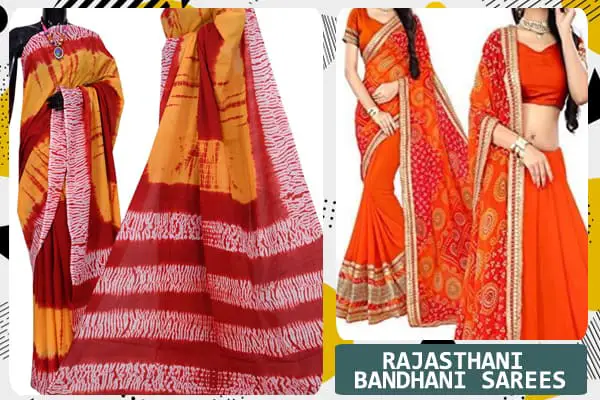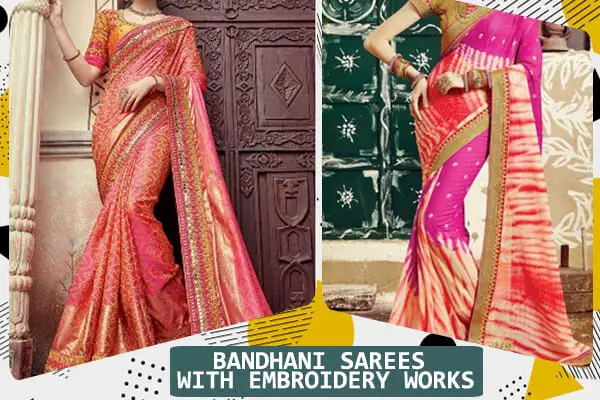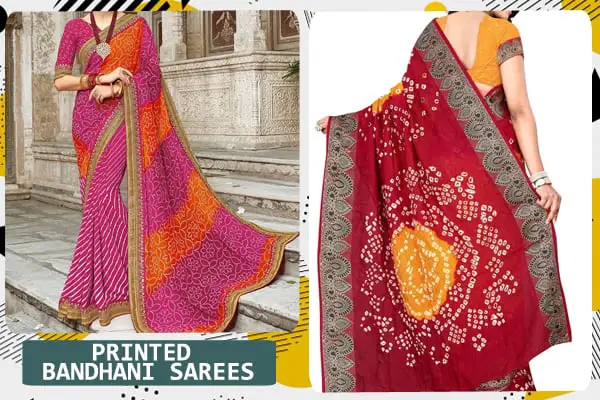The term bandhani is derived from the Sanskritic language verbal root bandh (“to bind, to tie”). These days, most Bandhani creating centers square measure settled in Gujarat, Rajasthan, Sindh, Punjab region and in Madras wherever it is known as Sungudi. The earliest evidence of Bandhani dates back to Indus Valley Civilization were dying was done as early as 4000 B.C.
The earliest example of the foremost pervasive variety of Bandhani dots will be seen in the sixth-century painting’s depiction the lifetime of Buddha found on the wall of Cave one at Ajanta. Bandhani is also known as Bandhej Saree, Bandhani, Piliya, and Chungidi in Tamil and regional dialects.
Other tying techniques include Mothra, Ekdali, and Shikari depending on the style during which the fabric is tied. The final products are known by various names including Khombi, Ghar Chola, Patori and Chandrakant The art of Bandhani is a highly skilled process.
The technique involves coloring a material that is tied tightly with a thread at many points, thus producing a variety of patterns like Chandrakala, Bevan Baug, Shikari etcetera; based on the manner in which the cloth is tied uniquely. The main color used in Bandhani are yellow, red, blue, green and black. The colors used in Bandhani are natural. As Bandhani may be a tie and dye method, dying is done by hand and hence best colors and combinations are possible in Bandhanis.
The Bandhani work has been completely doling out by the Khatri community of Kutch and Saurashtra. A meter length of material will have thousands of little knots referred to as ‘Bhindi’ within the native language (‘Gujarati’). These knots type a style once opened when coloring in bright colors. Traditionally, the final products can be classified into ‘khombi’, ‘Ghar Chola’, ‘Chandrakhani’, ‘Shikari’, ‘Chowkidar’, ‘Ambadaal’ and other categories.
Ahmedabad in India is known for Bandhanis. Bandhani work is additionally drained Rajasthan state however having differing types of colors and styles than the tannin and Saurashtra of Gujarat. Establishments of varied sizes within the entire tannin belt in Gujarat manufacture many sorts of Bandhani.
This Bandhani vogue is named because the Kutchi Bandhani, which is also practiced in the Saurashtra region of Gujarat. Bandhani ligature is commonly a family trade, and the women of these families work at home to tie patterns. Pethapur, Mandavi, Bhuj, Anjar, Jetpur, Jamnagar, Rajkot, square measure a number of the most cities in Gujarat, where Bandhani is created.
The city of Bhuj, placed within the Gulf of tannin, in Gujarat is accepted for its red Bandhani. Dyeing process of Bandhani is carried out extensively in this city because the water of this area is known to give an epic brightness to colors, specifically reds, and maroons. In Bandhani, different colors convey different meanings. People believe that wearing Red brings good luck to a newlywed’s life.
HISTORY OF BANDHANI SAREES :

The art of Bandhni has its roots in the parched soil of Gujarat. The heart-touching beauty of bandhej was soon revered by women in the states of Rajasthan and Uttar Pradesh. The earliest evidence of Bandhani dates back to Indus Valley Civilization where dying was done as early as 4000 B.C.
The earliest example of the foremost pervasive variety of Bandhani dots will be seen within the sixth-century painting’s depiction the lifetime of Buddha found on the wall of Cave one at Ajanta It hails from a time when the Rajas and Maharajas ruled the holy soil of India.
These sarees were treasured by women in those days as they had an exclusive artistic and creative value. Bandhni is precisely prints created on saree using tie & dye technique. These drapes come in vibrant colors that can instantly brighten up the visage of any woman. Each block of bandhni print was handcrafted.
Craftsmen with their mastery, employed threads to tie tight knots in a certain pattern on the entire canvas of the saree. This fabric was then dipped into a tub of color to give it an endearing hue. It was then scheduled to be air-dried for a certain amount of time before the knots were finally untangled from the drape.
The traditional technique of bandhni has survived through ages and sarees made by employing this technique is loved by women across the Indian subcontinent. In fact, the love for these sarees is spreading throughout the globe, as bandhani sarees are being exported globally.
The Navratri is considered an auspicious festival that is celebrated mainly in the north and north-western parts of India. On this occasion, women adorn beautiful colors and merge in with the spirit of the festival. Vibrant bandhani sarees on Navratri will look immaculate. They are available in a plethora of colors and designs, often characterizing mirror-works, sequins, embroidery, and other embellishments often adorn these endearing sarees that are available in an ample number of fabrics.
There are various designs of bandhani available, Akali (single knot), trikunti (triple knots), Dungar shahi (mountain pattern), Kodi (teardrop pattern), chaubandi (four dots), etc. Each design has its own significance and beautifies the canvas of a saree in a different way. These traditional sarees give its wearer a traditional look that has an embedded ethnic air. Its elegance, charm, and grace lend a mesmerizing aura the one who adorns it.
TYPES OF BANDHANI SAREES BASED ON MATERIALS:
Bandhani sarees are usually made with cotton. However, the new generation sarees are experimented using a variety of fabrics and techniques to suit the tastes of every woman. Fabrics such as chiffon, georgette, silk and cotton silk. Depending on the fabric type, the skill and effort involved with the dying process also vary.Bandhani sarees square measure most popular by girls of all age teams, particularly those who belong to the Rajasthani and Gujarati communities.
These sarees are their signature style, with middle-aged women generally opting for simple cotton Bandhani sarees. The youngsters tho’, like richer hues and falling materials like chiffon and material. Traditionally, fine mill-made kinds of cotton or Muslims were wont to produce Bandhani.
The modern artisans, given the dynamical preferences, additionally work on fine georgettes, art silks, silk-cotton blends, viscose and cotton variants. Pure Venkatagiri cotton, sourced from Andhra Pradesh, is employed to form ancient Ghar cholas. Georgettes with pure Banarasi brocade borders area unit wont to create vivacious and vibrant, high-end Jhankaar Bandhanis.
TYPES OF BANDHANI SAREES BASED ON DESIGNS :
Owing to an excellent demand, Bandhani is additionally wiped out Silk. However, pure silk, on its own, is fragile and lacks the resilience labyrinthine, tight attachment and unraveling want. Silks run the chance of tearing. Delicate silk may additionally lose its texture, given the crushing and crinkling. Pure silk bandhani, thus, area unit rare and big-ticket. Most silk materials used for Bandhanis area unit emulsified with cotton or viscose.
Pure georgettes (made from silk fibers) are very common as base materials for crafting big-ticket Bandhani. Silk luster and wonder area unit quite wanted, additional therefore in Bandhani sarees, as they’re closely related to auspicious occasions. Since pure silk lacks the lastingness needed for the Bandhani method, materials area unit fortified with poly fibers, etc. The ensuing blends area unit additional agile and fewer big-ticket.
One such poly-silk mix, used avidly to craft Bridal Bandhanis, is Gaji Silk. This base material is thicker, lustrous and sleek, maybe unreal in vivacious colors and is powerful enough to face up to significant elaborations like Zari borders, Zardozi embroidery etc. Gujarati Gharchola, Planetary, and Bandhani Wedding Lehenga Cholis are crafted in gaji silk. However, there are varieties of Bandhani sarees depending on the designs as listed below:
1. GUJARATI BANDHANI SAREES

Gujarat is the second common destination for authentic Bandhani sarees. This handmade tannic acid Bandhej sarees comes during a stunning red and dark inexperienced combination. The white squares all over the saree complement the dark hues quite well. The border comes during a distinctive Zari weave that renders an expensive look and feels to the sarees. It is always designed with red and dark green mixed shades. It will be a perfect ethnic and festive wear of all times.
2. RAJASTHANI BANDHANI SAREES

Rajasthani Bandhani sarees are colorful and rich. This particular piece reflects the true spirit of the age-old technique. The combination of orange and pink makes it perfect for all auspicious events. The sarees have been fastidiously created with thousands of bandhani knots to confirm most coverage on the sarees. The embellished Zari border elevates the look of the saree. It always comes in georgette type and suitable for all occasions.
3. BANDHANI SAREES WITH EMBROIDERY WORKS

This adorned Bandhani sarees with embroidery works offers you major searching goals. Preferably the white and red combination makes it one amongst the simplest Bandhani Wedding Sarees. The saree is tastily done by making the Bandhani look on the pallu and also the border. The outer border has an embroidered trimming which renders a grand look to the saree. The pleats have subtle embroidery to make it a unique piece. These are made with silk which makes it undoubted wear for weddings.
4. BANDHANI SAREES WITH MIRROR WORKS

The mirror works square measure on the entire border of the frock. The mirrors square measure connected to the frock with multi-colored thread works that looks wondrous. The opposite part of the frock is of vivacious multicolored works. It comes in silk and satin materials that suit for any special occasions.
5. BANDHANI SAREES WITH KUNDAN WORKS

Kundan works are blended with bandhani style saree to have designer look. These sarees have a light and soft texture which can be worn in special events maintaining the traditional looks. It is made from georgette and suits for occasions like parties.
6. PRINTED BANDHANI SAREES

The Bandhani print is often found on the Gharchola sarees & dupattas worn by women in Gujarat and even on the men’s turbans from Rajasthan. The basic reminder Bandhani print area unit red, yellow, inexperienced and blue. However, the print can be adapted into any color. The most commonly used fabrics for bandhani prints are silk, cotton, cotton silk, chiffon, georgette, and various other fabrics.
SPECIALITY OF BANDHANI SAREES :
- The craftsmen can be easily recognized with their little fingernail growth. It helps them to easily lift the cloth for tying. Some have a metal ring with an edgy point design in them. These are the qualities of the Rajasthan artisans but the Gujarati workers don’t use these techniques to work.
- The major color schemes used are the yellow, red, green and black and the colors are mostly bright, deep and dark. The colors have special significances such as red is the symbol of marriage, saffron is the color of divinity, yellow stands for the spring season of the new start and finally black and maroon are for mourning.
- The dyes are mostly made of natural ingredients such as leaves, roots, and flowers.
- The popular design patterns used are dots, squares, waves, and stripes. The designs are named such as “Ekdali” (single knot), Trikunti (three knots), Chaubandi (four knots), Dungar shahi (mountain pattern), Boond (small dot with a dark centre), Kodi (teardrop shape), laddu jalebi (round Indian sweets) and leheriya (waves).
- The costing is decided according to the number of tie-ups in the fabric/garment. The most intricate design in a saree will consist of approximately 75,000 dots or tie-ups. bandhani bandhej saree
- The bandhani material is folded twisted, with knotting. The folds are to be pulled out so that the knots are opened.
- Each area tribe and caste has their particular specialty of designs, moreover, the handicraft of bandhani and patola are the outstanding examples of the Indian dyeing art form.
TIPS FOR MAINTAINING BANDHANI SAREES

- Maintaining Bandhani sarees (and all materials with Bandhani) is incredibly vital because it could be a delicate craft which will lose color and vibrant, as a result of neglect.
- Bandhani sarees area unit rigorously roll-pressed and finished, before they’re sold. A similar method has to be followed by the user, before each wear.
- Use solely iron to iron these sarees. every Bandhani sari should solely be DRY cleansed (petrol washed), or it’ll lose its color.
- An honest quality sari fall should be connected to the present sari, as this area unit delicate sarees.
- It is important to take care of a Bandhani sari because it is created of loose and vivacious colors. These sarees area unit rigorously rolled, ironed and end before returning into the market.
- The identical method ought to be followed by the sari owner, try and press it with an iron. This sari is delicate in nature so that they could lose their color if washed harshly.
- Do not use detergents with high power chemicals.
- Preferably dry in partial sun.
- Do not soak in detergents too long as it may lose its authenticity.
- While storing avoiding using sprays, naphthalene balls as it may ruin the sarees.
- Last but not least beware of color bleeding because these materials are delicate and color
POPULAR BLOUSE DESIGNS FOR BANDHANI SAREES:
With the fashion scene changing at the drop of a hat, there is one piece of garment that is timeless. And, if there is one thing that can enhance this affable array, it is only the blouse. So, if you want to take your saree game to another level, up your blouse game, everything else can take a back seat. And, the access to talented fashion designers is ubiquitous, thanks to the technology. Here are few days ideas to let you decide how to choose blouse design for sarees.

- Square Neck Blouse Designs
- Round Neck Blouse Designs
- Sheer Sleeves Blouse Designs
- Backless Blouse Designs
- Cape Style Blouse Design
- Jacket Style Blouse Design
- Knotted Saree-Blouse Design
- Back Button Blouse
- 3 Tier Blouse Design
- Embroidered Loop Blouse
- Laced n Knotted Blouse
- Chinese Collar Blouse Design
BANDHANI SAREE PRICE :
| Sr. No. | Bandhani Sarees List | Price (Rs) |
| 1. | Multicolor printed bhagalpuri saree with blouse | Rs 611. |
| 2. | Bandhani printed bhagalpuri silk saree with blouse | Rs 562. |
| 3. | Multicolor hand woven silk saree with blouse | Rs 2199. |
| 4. | Navy blue printed chiffon saree with blouse | Rs 619. |
| 5. | Beige embroidered georgette saree with blouse | Rs 1709. |
| 6. | Bandhani printed bhagalpuri silk saree with blouse | Rs 562. |
| 7. | Multicolor woven art silk saree with blouse | Rs 2099. |
| 8. | Multicolor hand woven art silk saree with blouse | Rs 1999. |
| 9. | Green printed chiffon saree with blouse | Rs 669. |
| 10. | Maroon printed georgette saree with blouse | Rs 3744. |
POPULAR PLACES TO BUY BANDHANI SAREES :
In today’s scenario, these sarees can be bought from anywhere, even we can buy it online. But as mentioned above authentic sarees can be bought only from Gujarat.
Time and Tide waits for none, so do not waste your start shopping Bandhani sarees and feel like Queen.







